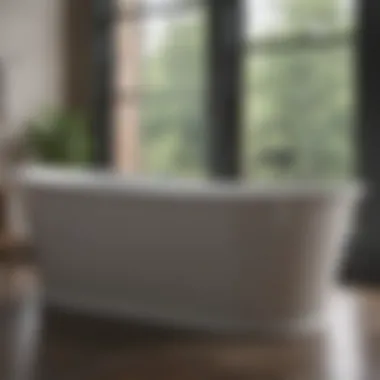Acrylic vs Cast Iron Tubs: A Comprehensive Comparison


Intro
When selecting a bathtub, the choices can seem overwhelming. Two popular options are acrylic soaking tubs and cast iron tubs. Each type comes with its own set of characteristics, advantages, and limitations. Understanding these differences is essential for homeowners and designers alike. This guide delves deep into the comparison, assisting you in choosing the right tub that suits your bathroom design, lifestyle, and preferences.
Design Inspiration
Incorporating either acrylic or cast iron tubs into your bathroom can significantly affect its overall aesthetic. The choice not only impacts style but also harmonizes with current trends in interior design.
Current Trends in Interior Design
Acrylic tubs tend to lean towards modern or contemporary styles. Their sleek lines and various shapes make them versatile additions. On the other hand, cast iron tubs often evoke a more traditional or vintage ambiance. They provide a sense of heaviness and permanence that some modern spaces may feel lack.
Color Schemes and Palette Ideas
Choosing the right color can enhance the appeal of your chosen tub. Acrylic tubs are often available in a range of colors, allowing you to match them with several design themes. Cast iron, while primarily white or a limited palette, can be painted. However, it’s crucial to manage expectations regarding wear and maintenance when considering this option.
Here are a few color pairing ideas:
- Acrylic Tub: Combine a soft pastel shade with earthy tones for a calming effect.
- Cast Iron Tub: Traditional white against bold navy for classic elegance.
When selecting your tub, consider the surrounding decor as well. A cohesive design showcases your style and enhances the room's overall feel.
Prelims to Bathtub Materials
Choosing the right bathtub is far more than just a style preference; it is a decision that can impact the overall functionality, comfort, and aesthetic of a bathroom. Bathtubs come in various materials and shapes, but two of the most common options are acrylic and cast iron. Each material possesses its unique characteristics that cater to different needs and preferences. The comparison between these two types highlights essential factors like durability, maintenance, and thermal properties.
When evaluating materials, it is crucial to consider how they align with your specific requirements. Acrylic tubs are lightweight and offer versatility in design, while cast iron tubs stand out for their longevity and classic appearance. Your choice should be informed by not only personal taste but also practical considerations such as ease of installation and upkeep. These aspects are vital for homeowners or designers looking to create a functional and appealing bathroom space.
Understanding bathtub materials is also significant in terms of long-term investment. A bathtub is not merely a decorative touch; it is a functional centerpiece of your bathroom. Selecting a material that aligns with your lifestyle and preferences can enhance satisfaction over years of use. Thus, delving into the qualities of acrylic and cast iron tubs enables informed decision-making that balances both form and function.
"The choice of bathtub materials influences not just comfort, but also the longevity and value of your home."
The Importance of Choosing the Right Bathtub
The importance of selecting the correct bathtub cannot be overstated. It serves as a space for relaxation, personal hygiene, and sometimes even recreational activities. Thus, the material itself significantly affects these experiences.
- Allergies and Sensitivities: Certain materials may be more suitable for people with sensitive skin or allergies. For example, acrylic tubs typically have a smoother surface compared to cast iron.
- Installation and Weight Considerations: The weight of the bathtub can affect installation logistics. Cast iron tubs tend to be much heavier, requiring additional support.
- Resale Value: A well-chosen bathtub can raise property values, appealing to potential buyers who value specific features.
In summary, the correct bathtub choice goes beyond mere appearance. It involves a mix of personal preferences, practical needs, and long-term considerations. Therefore, homeowners should approach this decision thoughtfully to ensure it complements their overall bathroom design and meets their daily needs.


Overview of Acrylic Soaking Tubs
In the realm of modern bathroom design, acrylic soaking tubs have gained significant traction for their blend of function and style. This section elucidates the fundamental aspects of acrylic tubs, examining their unique composition, advantages, and disadvantages. Homeowners and interior design enthusiasts often consider acrylic soaking tubs for their versatility and appealing aesthetics, but it is essential to weigh both benefits and potential drawbacks to make an informed decision.
Material Composition and Characteristics
Acrylic tubs are primarily composed of a thermoplastic material known as acrylic. This substance is a type of polymer that is known for its clarity and strength. Generally, acrylic is reinforced with fiberglass for added durability. The process of manufacturing involves shaping sheets of acrylic into desired forms, making it possible to create various styles and designs. One of the significant characteristics of acrylic is its smooth surface, which often makes it feel comfortable against the skin. This quality also facilitates easy cleaning, which is a sought-after feature in any bathtub.
Advantages of Acrylic Tubs
Lightweight and Easy to Install
Acrylic soaking tubs are notably lightweight compared to their cast iron counterparts. This feature leads to easier handling and installation. The reduced weight allows for simplified transportation, reducing the effort and manpower needed during the installation process. For those who may want to undertake a DIY home renovation, the lightweight nature of acrylic tubs can be highly beneficial. This factor makes them a popular choice among homeowners looking to remodel their bathrooms.
Variety of Styles and Colors
One of the distinguishing aspects of acrylic tubs is the extensive variety available in styles and colors. From freestanding designs to alcove configurations, acrylic soaking tubs offer options to suit various tastes. This flexibility allows homeowners to personalize their spaces according to their unique aesthetics. The ability to choose from various hues and patterns further enhances this option. Whether one prefers a sleek, modern look or a more traditional aesthetic, there is likely an acrylic tub that fits the bill.
Good Thermal Retention
Acrylic tubs are known for their excellent thermal retention properties. This characteristic means the water in an acrylic soaking tub can remain warm for extended periods. For individuals who appreciate prolonged baths, this feature contributes significantly to comfort and relaxation. The insulating qualities of acrylic also mean that homeowners can enjoy a soothing soak without constant adjustments to the water temperature.
Disadvantages of Acrylic Tubs
Susceptibility to Scratching
One of the notable disadvantages of acrylic tubs is their susceptibility to scratching. While they may be durable, regular use can lead to surface scratches that detract from the tub's appearance. This is particularly a concern for households with pets or children, where toys and other objects may come into contact with the tub's surface. Regular maintenance and protective products can reduce this issue, but it remains a factor to consider.
Potential Color Fading
Another concern with acrylic is the potential for color fading over time. Prolonged exposure to sunlight or harsh cleaning chemicals can affect the vibrant colors of some models. Homeowners should be mindful of choosing materials that withstand their specific bathroom conditions. Considering a model with UV protection during purchase can help mitigate this issue, but it is still an important factor to consider.
Less Resistant to High Temperatures
Finally, acrylic tubs have a characteristic of being less resistant to high temperatures compared to cast iron. While they can handle warm water, very hot temperatures can possibly warp the material or even lead to cracks over time. This limitation means homeowners should be cautious when filling an acrylic tub with excessively hot water, prioritizing longevity over immediate comfort. This specific trait is critical in the decision-making process when considering soaking tubs for regular use.
Overview of Cast Iron Tubs
Cast iron tubs have been a popular choice in bathroom design for many years. Their robust structure offers a sense of luxury and longevity that appeals to both homeowners and designers. This section explores the unique characteristics, advantages, and disadvantages associated with cast iron tubs, emphasizing why they remain relevant in modern design. By understanding these elements, readers can better appreciate how cast iron fixtures contribute to both functional and stylistic aspects of the bathroom.


Material Composition and Characteristics
Cast iron is a material made from iron and carbon, known for its hardiness. The casting process allows for the creation of durable, seamless shapes, suitable for bathtubs. The outer surface is typically coated with enamel, providing a smooth finish. This enamel layer protects the iron beneath while giving the tub its aesthetic appeal. The thick walls of cast iron tubs make them heavier than their acrylic counterparts, contributing to their stability and long-lasting nature.
Advantages of Cast Iron Tubs
Exceptional Durability
The exceptional durability of cast iron tubs is a core reason they are favored in many homes. Unlike plastic or fiberglass, cast iron can resist wear and tear over decades. This longevity means less frequent replacements, which is an economic advantage in the long run. The unique feature of this durability is that it can withstand daily use without significant signs of damage. This aspect makes it a favored option for households aiming for lasting quality.
Excellent Heat Retention
Another significant benefit of cast iron is its excellent heat retention. The thick walls allow it to maintain water temperature longer than many other materials. This means users can enjoy a warm soak without frequently adding hot water. This characteristic is particularly beneficial for those who savor long bath sessions. The thermal properties contribute to a more comfortable experience, making them a desirable choice for leisure and relaxation applications.
Classic Aesthetic Appeal
Many homeowners appreciate the classic aesthetic appeal of cast iron tubs. Their traditional look can elevate the visual context of a bathroom, creating a vintage or elegant atmosphere. The enamel finish is not only easy to clean but can also come in various colors, although typically more limited compared to acrylic. This timeless design feature resonates with those who prioritize style alongside functionality, ensuring that cast iron remains a salient option in bathtub selections.
Disadvantages of Cast Iron Tubs
Heavy Weight
One of the notable disadvantages of cast iron tubs is their heavy weight. Moving and installing these tubs can be a considerable challenge. It often requires professional assistance, elevating the installation costs. This aspect should be carefully considered, as weight can limit options in certain bathroom layouts or structures, especially in older buildings not designed to support such heavy fixtures.
Potential for Rusting
While cast iron is known for its durability, it is susceptible to rusting if not properly maintained. Any chips or cracks in the enamel finish can expose the iron below, leading to corrosion. Regular inspections and minor repairs can prevent this issue. Thus, understanding maintenance is crucial to preserving the tub’s longevity and aesthetic quality.
Limited Color Options
Lastly, the color options available for cast iron tubs are more limited compared to acrylic. Most cast iron tubs come in staple colors such as white or off-white. While these classic choices can complement various bathroom designs, they may not suit every homeowner's vision for personalization. If color diversity is a priority, this limitation might be a drawback when choosing a cast iron tub.
In summary, while cast iron tubs offer remarkable durability and design aesthetics, potential buyers must weigh their heavy weight and maintenance needs against the benefits.
Comparative Analysis: Acrylic vs. Cast Iron
The comparative analysis between acrylic soaking tubs and cast iron tubs serves as a crucial element of this article. Understanding the differences and similarities between these two popular materials enables homeowners and designers to make informed decisions that fit their needs. Choosing the right bathtub impacts not only the bathroom's functionality but also its aesthetic and resale value. An objective comparison can illuminate key attributes that influence durability, maintenance, thermal insulation, aesthetic appeal, and cost factors.
Durability and Lifespan


Durability plays a significant role in selecting a bathtub. Acrylic tubs have notable resistance to chips and cracks, making them a reliable choice in typical use scenarios. However, they can be susceptible to scratches from abrasive cleaning agents or rough objects. In contrast, cast iron tubs are celebrated for their exceptional durability. They can withstand significant wear and tear over time without showing signs of aging. While acrylic may provide a longer-lasting finish, cast iron's structural integrity often surpasses that of acrylic when properly maintained.
Maintenance Requirements
Maintenance varies substantially between acrylic and cast iron. Acrylic tubs often require gentle cleaning products to avoid damaging their surface. The occasional application of a polish can help maintain their shine. Regular upkeep is essential to prevent scratches and discolorations. Conversely, cast iron tubs need a different approach. They can be cleaned with harsher products, but care must be taken to avoid damaging the enamel finish. Rust may develop if the surface is chipped, which necessitates periodic inspections and touch-ups. Thus, each material demands distinct maintenance strategies to remain in optimal condition.
Thermal Insulation Properties
Thermal insulation is a critical aspect of tub selection, especially for soaking tubs. Acrylic tubs offer good thermal retention, keeping the water warm longer compared to many alternatives. The material’s inherent insulating properties help maintain the temperature, providing a comfortable soaking experience. On the flip side, cast iron excels in heat retention. Its thick structure holds heat efficiently, facilitating extended bathing sessions without needing constant reheating. This characteristic represents a significant advantage for those who prioritize long baths.
Cost Considerations
Cost consideration plays a vital role when making your choice between acrylic and cast iron tubs, as both initial expenses and long-term value can sway decision-making.
Initial Purchase Price
The initial purchase price is often more affordable for acrylic tubs. Homeowners may find a wider range of price points, making them accessible for various budgets. The pricing reflects the lightweight material and ease of installation. Thus, acrylic is a popular choice for those looking to manage upfront costs effectively. In contrast, cast iron tubs typically command a higher price due to their robust construction. Their initial cost can be a deterrent for some, but many view this as a worthwhile investment given long-term durability.
Long-term Value Analysis
Long-term value analysis weighs both the performance and lifespan of the tubs against their purchase price. Acrylic tubs, while initially less expensive, may not provide the same longevity as cast iron. Over time, users might face issues like scratching or discoloration that could require costly repairs or replacements. Conversely, cast iron tubs, with their exceptional durability, may represent a better long-term investment. Although they come at a higher upfront cost, their potential for a longer lifespan and minimal maintenance can lead to cost savings over the years. Thus, homeowners should assess their priorities when examining long-term value.
Aesthetic Considerations
Aesthetics is another vital factor in the choice between acrylic and cast iron. Acrylic tubs are available in diverse styles, colors, and shapes, allowing for greater customization. This flexibility can complement various bathroom themes, from modern to traditional. Cast iron tubs, while more limited in color options, boast a timeless elegance that appeals to many. The weight and feel of cast iron often lend a luxurious touch to the bathroom environment. Ultimately, the choice may hinge on personal preference and the desired aesthetic of the overall space.
Culmination: Making the Right Choice
The final decision between acrylic soaking tubs and cast iron tubs hinges on various factors that align with individual needs and lifestyle. This conclusion summarizes the insights presented in the article and highlights critical considerations for homeowners and designers.
Understanding these differences enables informed choices that not only satisfy aesthetic preferences but also meet practical requirements. Each tub material offers unique benefits and draws potential drawbacks. A clear evaluation of these aspects is crucial.
Key Factors to Consider
When choosing between acrylic and cast iron tubs, one must contemplate several key factors. These include:
- Durability: Cast iron offers exceptional durability compared to acrylic. The heavy-duty finish of cast iron stands up to scratches and dents better than acrylic, which can be prone to damage over time.
- Maintenance: Acrylic tubs require more frequent upkeep to maintain their appearance. On the other hand, cast iron, while heavier to install, might not need as frequent replacements or repairs.
- Heat Retention: A noteworthy element is thermal retention. Cast iron excels in retaining heat, enhancing the bathing experience, particularly in colder climates.
- Cost: While acrylic tubs generally have a lower upfront cost, the long-term value should also be analyzed considering maintenance and replacement costs.
- Aesthetics: The visual appeal plays a significant role in bathroom design. Cast iron often offers a more classic look, while acrylic can provide modern options with varied styles and colors.
Each factor needs careful assessment, considering both immediate and long-term implications on comfort and style.
Personal Preferences and Use Cases
Individual preferences weigh heavily in the decision-making process. For those who prioritize design flexibility and lighter weight, acrylic may be ideal. It offers more styles and colors, fitting diverse interior aesthetics. Additionally, if the primary concern is ease of installation, acrylic tubs are often simpler to handle.
Conversely, for homeowners who value longevity and a classic feel, cast iron is often the tub of choice. Its timeless appearance fits well with traditional designs. Homeowners in regions with cooler climates might favor cast iron for its heat-retaining properties that enhance comfort.
"The choice between acrylic and cast iron is not merely a matter of budget but also involves lifestyle considerations and personal taste."



